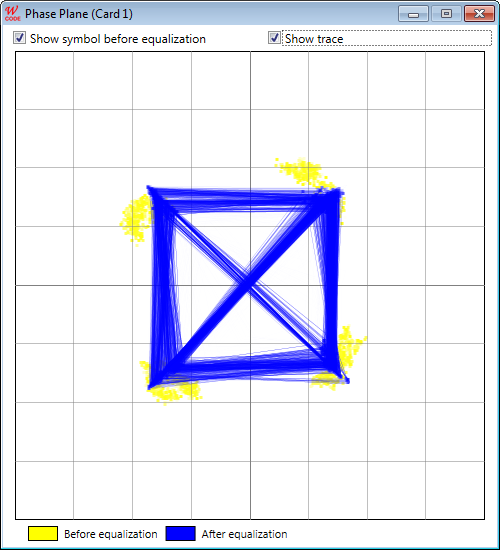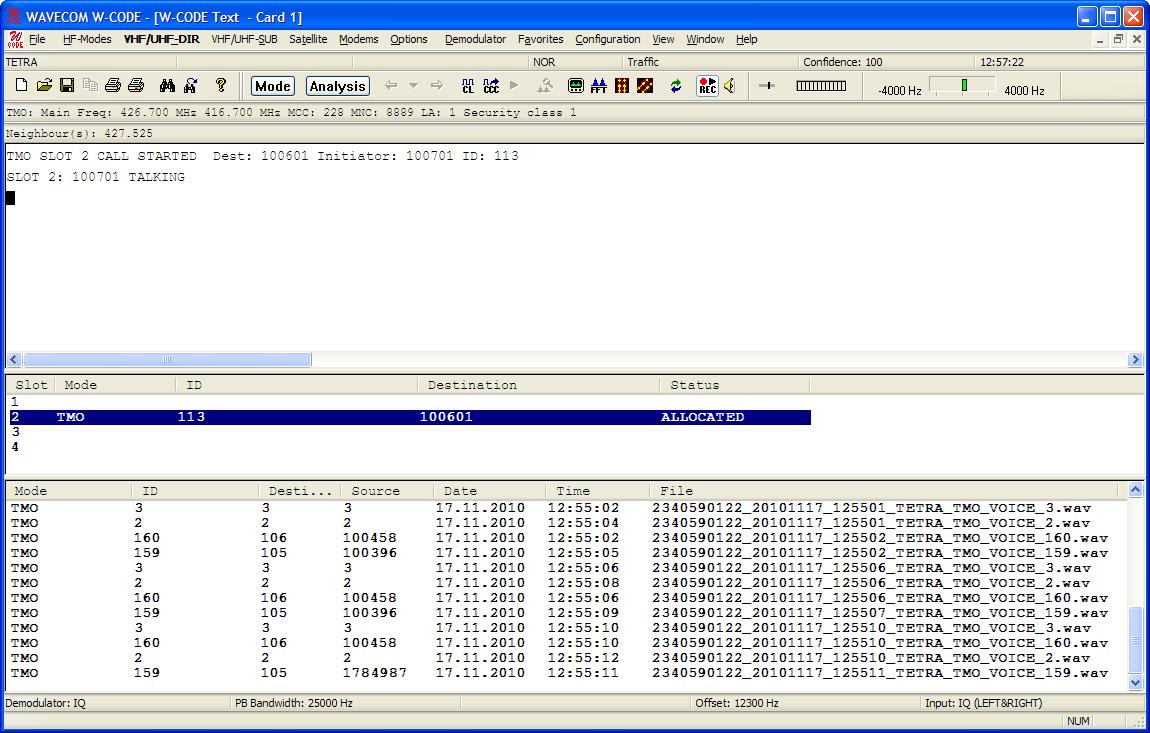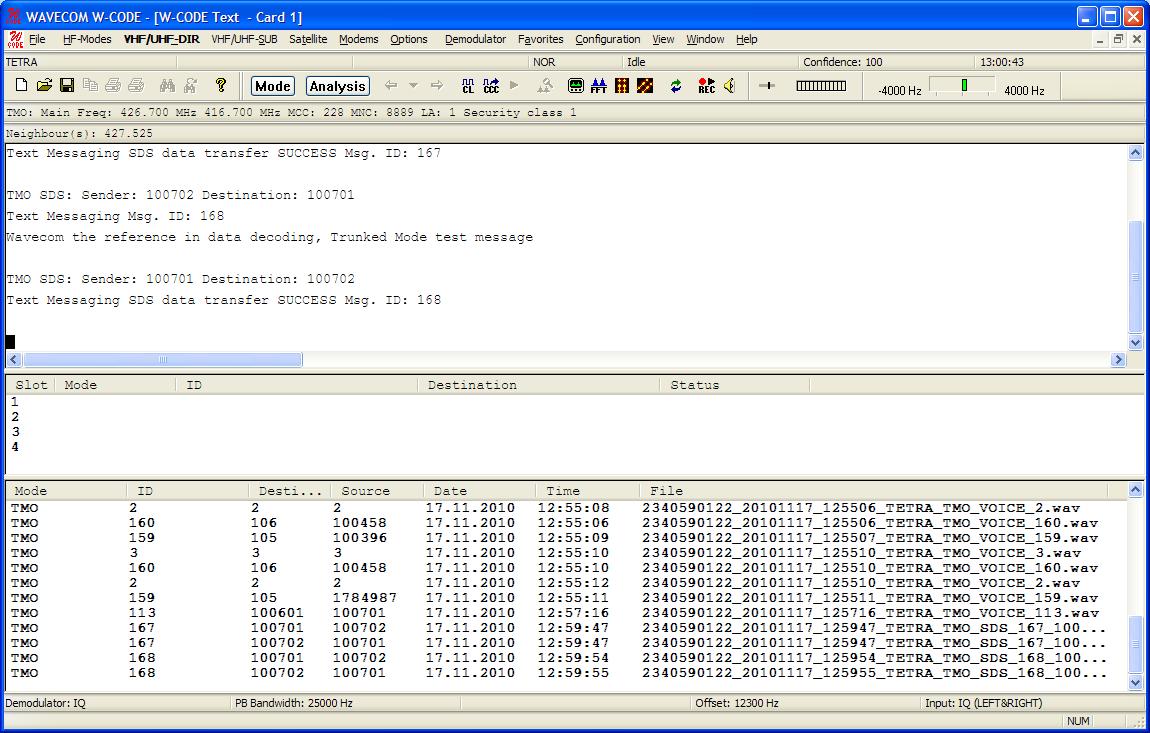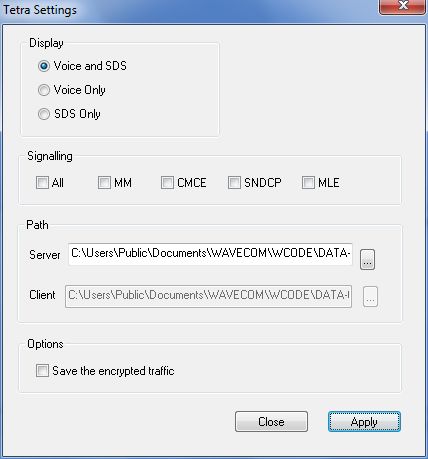
TETRA (TErrestrial Trunked Radio) is a digital voice and data system for mobile services standardized by ETSI and used for public safety and civilian PMR (Public Mobile Radio). It is closely related to GSM, but has its own unique features, e.g., a direct mode allowing mobile stations to communicate with each other without a base station and air interface encryption.
|
Parameter |
Value |
|
Frequency range |
CEPT common EU allocation UHF (Public safety: 385 – 390/395 – 399.9 MHz, civil applications: 410 – 420/420 – 430 MHz) |
|
Operation modes |
Digital voice and data system |
|
Symbol rate |
18 kBd |
|
Modulation |
π/4-DQPSK |
|
Receiver settings |
BW = 25 kHz |
|
Input format(s) |
IF |
|
Additional info |
Data or voice |
|
Operation modes |
Trunked (TMO V+D (Voice + Data)), direct (DMO) |
|
Access method |
TDMA (Slotted Aloha) |
|
Voice codec |
ACELP (4567 bps) |
A Short Data Service (SDS) similar to the SMS of GSM is available. SDS includes a number of protocols, and the WAVECOM decoder supports Text Messaging. For this type of messaging the text itself and delivery status reports are displayed and the messages saved to disk. The other data protocols are displayed as bits due to the lack of detailed protocol descriptions.
TMO and DMO voice calls in all time slots are decoded and can be monitored in real-time as well as saved to disk (in a .wav file) for later playback and analysis. The input bits to the vocoder are saved in Hex in a separate file alongside the .wav file. This feature is useful when the voice session is encrypted. The user can analyze and try to decrypt the bits.
This decoder uses soft-decision for demodulation and decoding, using the intrinsic information between two differential QPSK symbols. This improves the demodulation quality significantly than the traditional way by just sampling the symbol and making a hard (0 or 1) decision on the bit. This soft-decision demodulation is visualized in the phase plane (Options -> Show Phase Plane). The yellow symbols are the sampled symbols before demodulation and the blue ones are the ones after the demodulation.

TETRA Phase Plane.
User Interface
The user interface for TETRA consists of a three pane window similar to the GUI for the satellite modes and an options dialogue.
GUI for voice communication

In uppermost part of the GUI two status lines are continuously updated with system information: Mode (TMO or DMO), base station main frequencies, country code (MCC), network code (MNC), local area identification (LA), security class and the frequencies of neighbor base stations.
The upper pane will display signaling information for the signal being monitored. For voice the default display will show slot number, destination and source addresses, call ID and status. Other options are available from Options | Tetra Settings (see below).
GUI for SDS

The middle pane contains a list of active TMO and DMO voice sessions. Left-clicking an entry will highlight the row ant send the selected conversation to the audio output. Audio output can be enabled or disabled using the mute button

The lower pane contains a list of saved calls and SDS messages. By double-clicking a file a call or a message is retrieved and displayed or played back.
Tetra Settings…
Various options are available through Options | Tetra Settings…

|
Display |
The user may select what is to be displayed by clicking one of the radio buttons. |
|
Signaling
|
The checkboxes allows the user to display all layer 3 PDUs (Protocol Data Units) corresponding to the levels of the TETRA protocol stack (for protocol overview, see the WAVECOM white paper WP-TETRA or consult the appropriate ETSI documentation). PDUs from the following protocol entities are available: Mobile Link Entity (MLE) – Information on neighboring cells and control of cell reselection. Mobility Management (MM) - Controls various services, e.g., registration and de-registration, authentication, OTAR (Over-The-Air-Rekeying), mobile station stunning and group attachment. Sub-Network Dependent Convergence Protocol (SNDCP) – TETRA specific adaptation protocol for IP data. Circuit Mode Control Entity (CMCE) – Controls all voice and data (SDS). Call setup, maintenance and tear-down functions.
An excerpt of the display of PDUs, here CMCE and MLE PDUs. The PDUs in their entirety are not verbally interpreted – only the protocol name and the name of the PDU in question are displayed, whereas payload data is output as bits. The exception here are the SNDCP PDUs which are displayed in formatted as well as binary form. This allows for a better view on the context activation/deactivation as well as packet flow.
An excerpt of a formatted SNDCP PDU. If no PDUs are selected – this is the default setting - only the status messages generated by the CMCE protocol will be displayed. |
|
Path |
The paths for saving output data may be selected here. Use Server to set the Windows folder for the output files on the server. Use Client to set the Windows folder for the output files on the client. This option is only enabled on a remote GUI. |
|
Options |
Check this box if you want to save encrypted traffic for further analysis. |
|
Encryption
|
Encrypted data and voice poses specific problems for decoding as decryption of the payload is not attempted. TETRA offers air interface encryption which may cover data, signaling, identities etc. In the current decoder version encrypted traffic similar to other traffic will trigger the indication “TRAFFIC” in the status box, and an option (see preceding paragraph) is available for saving traffic to a text file containing cell information, destination address and payload data (if an allocation is received). In case of encrypted traffic packets, the payload data is saved together with the number of the slot, frame, multi-frame and hyper-frame being decoded which constitute the Initial Value (IV) for the encryption algorithm. Saved data and meta-information may be fed to an external decryption process. A sample of the text file containing encrypted voice and meta-data is shown below:
TMO: Main Freq: 393.912 MHz 383.912 MHz MCC: 000 MNC: 0000 LA: 15972 Security class 3 and class 1 CN: 3756 CC: 2 Encrypted Channel Allocation Dest: 568463 Slot: 1 Frame: 11 Enc. Mode: 2 1101110100010101000000000010110011001110111001000010000011111110111110010110000000001000000100001000000000000000000000000000000000000000000000000000000000000000000000000000000000000000000000000000000000000000000000000000 2 8 40 5337 (slot – frame – multi-frame – hyper-frame) 100001010111110011001110100001011000111110110100101100000110000111110011000100000001100101001000011010000111001010101011101011011010010101100100001011111010110110000111110011000111011100000001000011101100011010000111000011111100000001010100001101010100 |